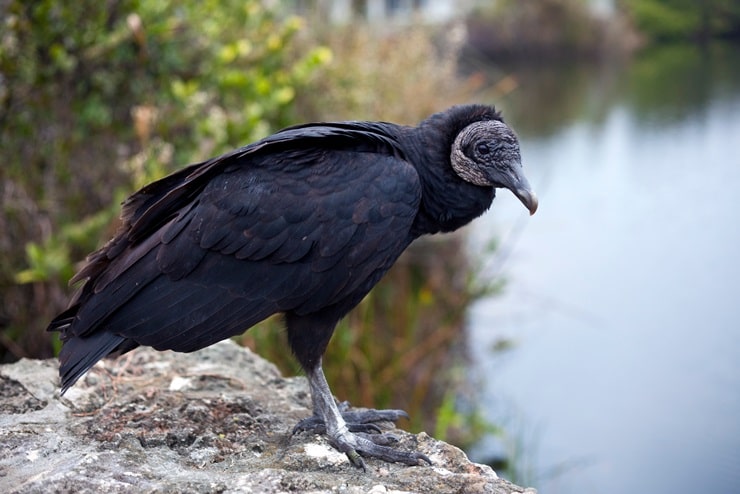Amidst impressive geographical diversity, from its many coastal shores to the wetland Everglades, Florida is home to a wide range of species. The delightful warm climate and warm water make this land ideal for a wide range of mammals, reptiles, birds and marine life. Spanning 65,758 square miles, Florida is a treasure trove for animal lovers and bird watchers.
Two common species of vultures you can find soaring in the sky above the Floridian canopy are the Black Vulture and the Turkey Vulture. Vultures in Florida have a stable food supply which supports a thriving, year-round population.
2 Types of Vultures in Florida
1. The American Black Vulture

- Scientific name: Coragyps atratus
- Length: 22–29 in (56–74 cm)
- Weight: 3.5 to 6.6 lb (1.6 to 3 kg)
- Wingspan: 52–66 in (1.33–1.67 m)
The American Black Vulture, more simply known as the Black Vulture, can be most commonly spotted in the sky gliding in rising warm air thermals.
The distinct markings of a Black Vulture are its grayish-black featherless head and neck, grayish-white featherless legs, and glossy black plumage. When in flight, the Black Vulture can be identified apart from other birds by its broad, straight wingspan that has five lighter colored primary feathers on each end.
The Black Vulture has a vast range of habitats that span across North, Central and South America. These vultures prefer open plains with interspersed trees and other high perches.
Black Vultures are typically non-migratory birds, with the exception of occasional short-distance migrations, and can therefore be seen year-round in their habitats.
Fun Fact: Though they are scavengers, Black Vultures more often prefer fresh meat and have even been known to kill prey.
2. Turkey Vulture

- Scientific name: Cathartes aura
- Length: 24–32 in (62–81 cm)
- Weight: 1.8 to 5.3 lb (0.8 to 2.41 kg)
- Wingspan: 63–72 in (160–183 cm)
Turkey Vultures, despite the name, are not turkeys at all, but rather vultures. Some refer to this bird as “turkey buzzard”, “buzzard” or “carrion crow”.
The plumage covering the Turkey Vulture’s body is brownish-black; there are no feathers on the head or feet of the Turkey vulture. Major distinctions for identifying a Turkey Vulture include its bright red head and legs, as well as its broad, “V” shaped wingspan that displays light-brown feathers on its underside.
The Turkey Vulture covers the widest range of all vulture species in the Americas and is the most abundant vulture worldwide.
This raptorial bird depends on open areas with nearby forests, such as agricultural areas as well as other manmade habitats. These vultures can even be spotted near open highways perched in trees or even on billboard advertisements!
Fun Fact: Turkey Vultures have a highly sensitive nose and can smell carrion up to eight miles away.
Facts About Vultures in Florida:
- These two vultures in Florida can be spotted year-round.
- Look for Turkey and Black Vultures in Florida on the roadside or near the highway as they often find “roadkill”, or carrion, there to eat.
- Black and Turkey Vultures in Florida commonly roost together in large groups.
- Due to the frequent rising warm-air thermals, vultures in Florida can be frequently found gliding and soaring in the sky.
- Both species of vultures in Florida are federally protected and it is against the law to harm or kill them.
Also Read: Woodpeckers in Florida Owls in Florida
